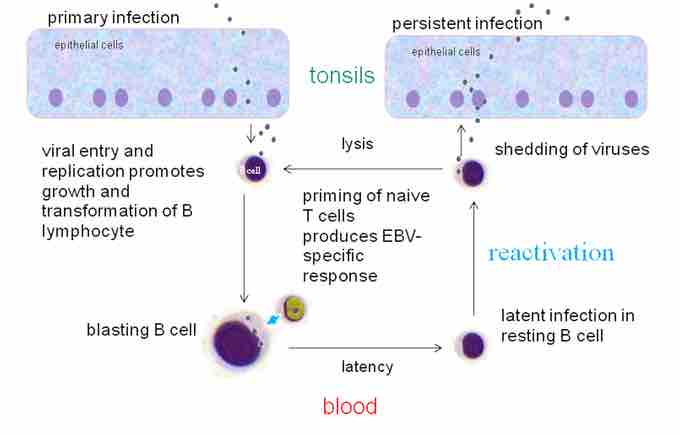The Epstein–Barr virus (EBV), also called human herpesvirus 4 (HHV-4), is a virus of the herpes family, and is one of the most common viruses in humans. EBV infection, which occurs by oral transfer of the saliva, results in infectious mononucleosis (glandular fever). It is also associated with particular forms of cancer, such as Hodgkin's lymphoma, Burkitt's lymphoma, nasopharyngeal carcinoma, and central nervous system lymphomas associated with HIV. There is evidence that infection with the virus is associated with a higher risk of certain autoimmune diseases, especially dermatomyositis, systemic lupus erythematosus, rheumatoid arthritis, Sjögren's syndrome, and multiple sclerosis. Most people become infected with EBV and gain adaptive immunity. In the United States, about half of all five-year-old children and 90 to 95 percent of adults have evidence of previous infection. Infants become susceptible to EBV as soon as maternal antibody protection disappears. Many children become infected with EBV, and these infections usually cause no symptoms or are indistinguishable from the other mild, brief illnesses of childhood.
A mature EBV viral particle has a diameter of approximately 120 nm to 180 nm. It is composed of a double stranded, linear DNA genome enclosed by a protein capsid. The capsid is surrounded by a protein tegument, which in turn is surrounded by a lipid envelope. The EBV genome is about 192 thousand base pairs in length and contains about 85 genes. The viral envelope is embedded with glycoproteins essential to viral entry into the cell.
EBV Infection Cycle
EBV infects B cells of the immune system and epithelial cells. Once EBV enters the cell, the viral capsid dissolves and the viral genome is transported to the cell nucleus. An EBV infection can be described as being in one of two cycles; a lytic replicative cycle and a latency cycle .

EBV infection cycle
Upon a primary infection, EBV enters the lytic replicative cycle where it infects blood cells. It will remain dormant during the latent stage until it is reactivated into the lytic cycle.
The lytic cycle, or productive infection, results in the production of infectious virions. EBV can undergo lytic replication in both B cells and epithelial cells. In B cells, lytic replication normally only takes place after reactivation from latency. In epithelial cells, lytic replication often directly follows viral entry entry. For lytic replication to occur, the viral genome must be linear. The latent EBV genome is circular, so it must linearize in the process of lytic reactivation. During lytic replication, viral DNA polymerase is responsible for copying the viral genome. Unlike lytic replication for many other viruses, EBV lytic replication does not inevitably lead to lysis of the host cell because EBV virions are produced by budding from the infected cell.
Unlike lytic replication, the latent stage does not result in production of virions. Instead, the EBV genome circularizes, resides in the cell nucleus as an episome, and is copied by cellular DNA polymerase. In latency, only a portion of EBV's genes are expressed. Latent EBV expresses its genes in one of three patterns, known as latency programs. EBV can latently persist within B cells and epithelial cells, but different latency programs are possible in the two types of cells. EBV can exhibit one of three latency programs: Latency I, Latency II, or Latency III. Each latency program leads to the production of a limited, distinct set of viral proteins and viral RNAs.
Presence and Symptoms of EBV
The EBV occurs all over the world and most people become infected with this virus at some point in their lives. When teenagers get EBV, there is a 35-50% chance that it will lead to infectious mononucleosis also known as mono. Symptoms of mono include fever, sore throat, pharyngitis, and swollen lymph glands (lymphadenopathy). Although the symptoms of infectious mononucleosis usually go away in 1-2 months, EBV remails dormant and hidden in the troat and blood cells for the rest of the person's life.